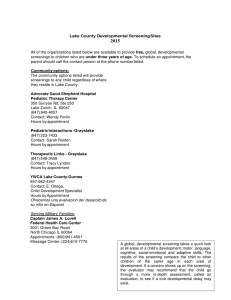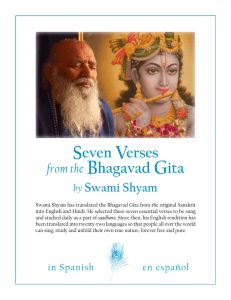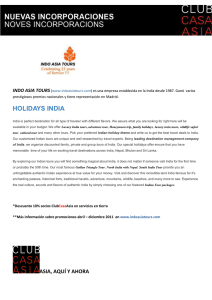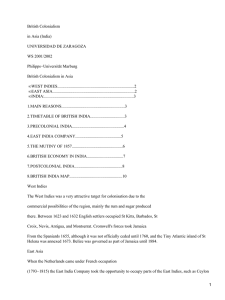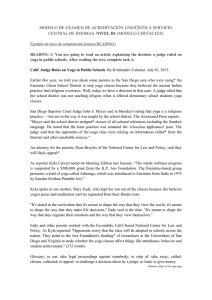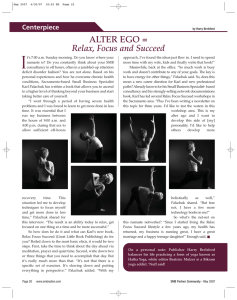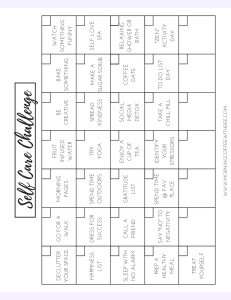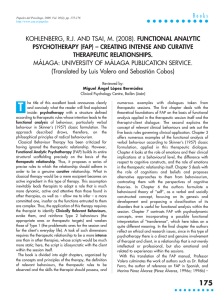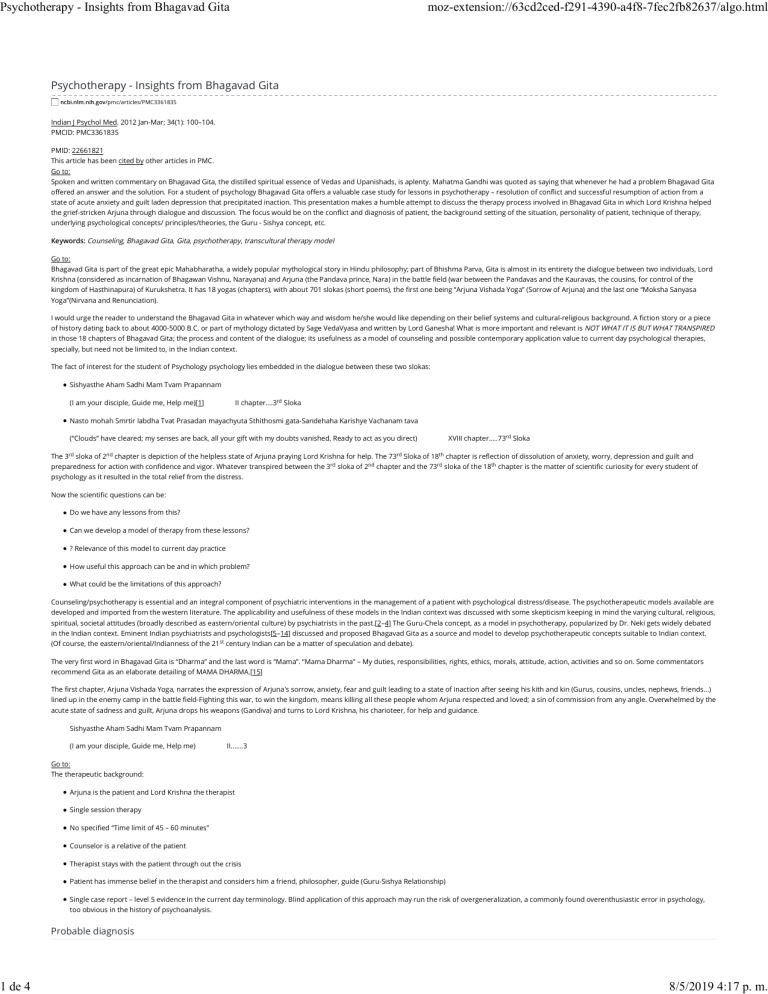
Psychotherapy - Insights from Bhagavad Gita 1 de 4 moz-extension://63cd2ced-f291-4390-a4f8-7fec2fb82637/algo.html Psychotherapy - Insights from Bhagavad Gita ncbi.nlm.nih.gov/pmc/articles/PMC3361835 Indian J Psychol Med. 2012 Jan-Mar; 34(1): 100–104. PMCID: PMC3361835 PMID: 22661821 This article has been cited by other articles in PMC. Go to: Spoken and written commentary on Bhagavad Gita, the distilled spiritual essence of Vedas and Upanishads, is aplenty. Mahatma Gandhi was quoted as saying that whenever he had a problem Bhagavad Gita offered an answer and the solution. For a student of psychology Bhagavad Gita offers a valuable case study for lessons in psychotherapy – resolution of conflict and successful resumption of action from a state of acute anxiety and guilt laden depression that precipitated inaction. This presentation makes a humble attempt to discuss the therapy process involved in Bhagavad Gita in which Lord Krishna helped the grief-stricken Arjuna through dialogue and discussion. The focus would be on the conflict and diagnosis of patient, the background setting of the situation, personality of patient, technique of therapy, underlying psychological concepts/ principles/theories, the Guru - Sishya concept, etc. Keywords: Counseling, Bhagavad Gita, Gita, psychotherapy, transcultural therapy model Go to: Bhagavad Gita is part of the great epic Mahabharatha, a widely popular mythological story in Hindu philosophy; part of Bhishma Parva, Gita is almost in its entirety the dialogue between two individuals, Lord Krishna (considered as incarnation of Bhagawan Vishnu, Narayana) and Arjuna (the Pandava prince, Nara) in the battle field (war between the Pandavas and the Kauravas, the cousins, for control of the kingdom of Hasthinapura) of Kurukshetra. It has 18 yogas (chapters), with about 701 slokas (short poems), the first one being “Arjuna Vishada Yoga” (Sorrow of Arjuna) and the last one “Moksha Sanyasa Yoga”(Nirvana and Renunciation). I would urge the reader to understand the Bhagavad Gita in whatever which way and wisdom he/she would like depending on their belief systems and cultural-religious background. A fiction story or a piece of history dating back to about 4000-5000 B.C. or part of mythology dictated by Sage VedaVyasa and written by Lord Ganesha! What is more important and relevant is NOT WHAT IT IS BUT WHAT TRANSPIRED in those 18 chapters of Bhagavad Gita; the process and content of the dialogue; its usefulness as a model of counseling and possible contemporary application value to current day psychological therapies, specially, but need not be limited to, in the Indian context. The fact of interest for the student of Psychology psychology lies embedded in the dialogue between these two slokas: Sishyasthe Aham Sadhi Mam Tvam Prapannam II chapter….3rd Sloka (I am your disciple, Guide me, Help me)[1] Nasto mohah Smrtir labdha Tvat Prasadan mayachyuta Sthithosmi gata-Sandehaha Karishye Vachanam tava XVIII chapter…..73rd Sloka (“Clouds” have cleared; my senses are back, all your gift with my doubts vanished, Ready to act as you direct) 3rd 2nd 73rd 18th The sloka of chapter is depiction of the helpless state of Arjuna praying Lord Krishna for help. The Sloka of chapter is reflection of dissolution of anxiety, worry, depression and guilt and preparedness for action with confidence and vigor. Whatever transpired between the 3rd sloka of 2nd chapter and the 73rd sloka of the 18th chapter is the matter of scientific curiosity for every student of psychology as it resulted in the total relief from the distress. Now the scientific questions can be: Do we have any lessons from this? Can we develop a model of therapy from these lessons? ? Relevance of this model to current day practice How useful this approach can be and in which problem? What could be the limitations of this approach? Counseling/psychotherapy is essential and an integral component of psychiatric interventions in the management of a patient with psychological distress/disease. The psychotherapeutic models available are developed and imported from the western literature. The applicability and usefulness of these models in the Indian context was discussed with some skepticism keeping in mind the varying cultural, religious, spiritual, societal attitudes (broadly described as eastern/oriental culture) by psychiatrists in the past.[2–4] The Guru-Chela concept, as a model in psychotherapy, popularized by Dr. Neki gets widely debated in the Indian context. Eminent Indian psychiatrists and psychologists[5–14] discussed and proposed Bhagavad Gita as a source and model to develop psychotherapeutic concepts suitable to Indian context. (Of course, the eastern/oriental/Indianness of the 21st century Indian can be a matter of speculation and debate). The very first word in Bhagavad Gita is “Dharma” and the last word is “Mama”. “Mama Dharma” – My duties, responsibilities, rights, ethics, morals, attitude, action, activities and so on. Some commentators recommend Gita as an elaborate detailing of MAMA DHARMA.[15] The first chapter, Arjuna Vishada Yoga, narrates the expression of Arjuna's sorrow, anxiety, fear and guilt leading to a state of inaction after seeing his kith and kin (Gurus, cousins, uncles, nephews, friends…) lined up in the enemy camp in the battle field-Fighting this war, to win the kingdom, means killing all these people whom Arjuna respected and loved; a sin of commission from any angle. Overwhelmed by the acute state of sadness and guilt, Arjuna drops his weapons (Gandiva) and turns to Lord Krishna, his charioteer, for help and guidance. Sishyasthe Aham Sadhi Mam Tvam Prapannam (I am your disciple, Guide me, Help me) II…….3 Go to: The therapeutic background: Arjuna is the patient and Lord Krishna the therapist Single session therapy No specified “Time limit of 45 – 60 minutes” Counselor is a relative of the patient Therapist stays with the patient through out the crisis Patient has immense belief in the therapist and considers him a friend, philosopher, guide (Guru-Sishya Relationship) Single case report – level 5 evidence in the current day terminology. Blind application of this approach may run the risk of overgeneralization, a commonly found overenthusiastic error in psychology, too obvious in the history of psychoanalysis. Probable diagnosis 8/5/2019 4:17 p. m. Psychotherapy - Insights from Bhagavad Gita 2 de 4 moz-extension://63cd2ced-f291-4390-a4f8-7fec2fb82637/algo.html This attempt to make a retrospective diagnosis based on the current day diagnostic criteria may sound ludicrous but the limitations are notified. We can only make a diagnosis of Acute, transient, situational adjustment disorder with symptoms of anxiety (? single Panic attack), depression with predominant guilt (core symptom - stain my hands with the blood of gurus and cousins). The available information does not satisfy criteria for Psychosis, Bipolar disorder, MDD or Anxiety disorder. No past history of psychological decompensation in spite of major psychological stressors (Aranyavasam, agnathavasam, humiliation in the royal court…) in the preceding years. The setting is battle field and the urgency of the issue demands crisis intervention. Personality of Arjuna: Pandava Prince, no significant neurotic traits, maladjustments or faulty coping pattern; a great warrior and veteran of many battles, in the recent past he fought against the same army and won the battle (Uttara Gograhanam). Proactive role in the preparation for the current war and he drove into the battlefield with great enthusiasm to fight and win. Therapist Lord Krishna - A long-time friend, relative, well wisher of the patient, highly respected in the community, supposedly with supernatural powers, legendary mediating skills, mischievous lover boy in his younger days, with tons of common sense and in the contemporary language a kind of Go-Getter. Descriptive psychopathology of Arjuna: Anxiety Seedanthi mama gatrani mukham cha parisushyathi vepathus cha sarire me roma-harshas cha jayate (Weakness of limbs, Dryness of mouth, Shivering of the body, Goose skin) 1……..29 Gandivam sramsate hastat tvakchaiva paridahyate na cha saknomy avasthatum bhramati va cha me manah (Gandivam slips from the hand, “Burning” of skin, Unable to stand, “Dizziness”/Confusion of Mind) I………30 Depression 1. Negative thoughts: Na kankhse vijayam Krishna na cha rajyam sukhani cha Kim no rajyena Govinda kim bhogairjivitena va. (Do not desire victory, Neither kingdom nor pleasures why kingdom, why luxuries, why this war, wh…..) I…….32 2. Guilt: Ahobatha MahatPAPAM karthum vyavasatha vayum Yadrajya sukhaobhena Hanthum Swajana mudyatham (Preparing for the SINful act of killing our own kin…) I……..44 3. Death wish: Yadi Ma Mapratheekaram asastram Sastrapanayah Dhartarashtra rane hanusthanme KSHEMAtharam bhaveth (Even if I get killed in the war by my enemy it will be good) I……45 Therapeutic process Cognitive / Rational emotive Approach: Discussion on the natural inevitability of birth and death of life cycle, immortality of soul, performance of your own Dharma (duty) otherwise running the risk of shame and public defame. Goal of therapy is removal of guilt and remotivate for action. Asochyan anvasochastvam Pragna-vadams cha bhashase gatasun agatasumscha n anusochanti panditah (You worry about events you are not supposed, and speak like a learned man, Wise people do not worry about things that are perishable, or immortal) II…….11 Vasamsi jirnani yatha vihaya navani grhanti naro parani tatha sarirani vihaya jirnany-anyani samyati navani dehi (As you remove torn clothes and wear new ones ATMA also leaves… and occupies new bodies) II………22 Nainam chindanti sastrani Nainam dahati pavakah na chainam kledayanty apo na soshayati marutah (ATMA CAN NEVER BE torn by arrows (bullets), Burnt by fire, Washed away by floods (Tsunami) lifted by winds (Typhoon, Hurricane) II……..23 Jatasya hi dhruvo mrtyuh dhruvam janma mrtasya cha tasmaad apariharye rthe na tvam sochitumarhasi (Every thing born must die, Every thing dead must get born again and you should not worry about these events) II……..27 Atha chethva mimam dharmyam sangramam na karishyasi Thatha swadharmam keerthin cha hitva Papamavasyasi (Your “Dharma” is to participate in war, If not You lose your dharma, fame and COMMIT A SIN) II……….33 ….Sambhavitasya Chakeerthi hi Maranadathirichyathe (For a noble man disgrace is worse than death) II……‥…34 Hathova prapsyasi swargam jitva va bhokshyase mahim thasmad utthistha Kaunteya yuddhaya krta-nischayah (If you die you will go to heaven, winning will get you kingdom So get up and decide to fight. II………37 Action and renunciation The one concept in Bhagavad Gita that received exceptional respect and applause from several great scholars is the emphasis on KARMA (ACTION). Intelligent action (Gnana Karma) without performance anxiety and without the greed for the fruits of the work (Nishkama Karma) and never to have the choice of nonperformance of duty (Akarma) emerges as a key point in the teaching of Bhagavad Gita. Karmany evadhikaras te Mma phalesu kaddacana Ma karma-phala-hetur bhur Ma te sango’stv akarmani (You have the right only on Action, Not on the fruits of your work Never own responsibility to the result, Must never lose interest in work) II……….47 Humanistic school: Emphasis on the power and capabilities of individual self, and how the person alone will be responsible for his actions, growth or otherwise. “You are your choices”. “You are your destiny” Uddharedatmana’tmanam atmanam avasadayet atm’aiva hy atmano bandhur atm’aiva ripur atmanah 8/5/2019 4:17 p. m. Psychotherapy - Insights from Bhagavad Gita 3 de 4 moz-extension://63cd2ced-f291-4390-a4f8-7fec2fb82637/algo.html (Self-Empowerment, No inferiority, Your “Self” can be your friend or your own enemy) VI……….5 Viswarupa-Darsanam - ? Hypnosis: Is the therapist inducing a state of hypnotic trance at this point! Vedanam Samavedosmi… Indriyanam Manasyasmi…. Naranam cha Naradhipam…. I am the best of everything - Omnipotent, Omnipresent…. X chapter Pasyame Pardha Rupani Sathasotha Sahashrasu….. (Arjuna, Look at my Hundreds and Thousnds of forms…) XI………..5 Trust (Bhakthi): Trust (Faith) remains a single most important element in the therapeutic relationship; not just in psychology but the medical practice in general. Sarvadharman Parithyajya Mamekam Saranam Vraja Aham Thva Sarvapapebhyo Mokshaishyami Ma Suchah (Leave everything and Trust me, I will rescue you from all the problems, Do not Worry) XVIII…….66 Guru – Sishya Relationship: Gurukul Tradition Imparting wisdom with devotion to learn and teach, dialogue and discussion being the process, bound by relationship of trust is the ancient tradition of Gurukul.[16] Therapeutic components: Satisfactory Premorbid Personality of the patient with adequate coping skills Therapist is a trusted Friend, Philosopher, Guide Catharsis, Ventilation! Cognitive and Rational emotive approach! Cognitive Distortions, Misinterpretations (SANKHYA YOGA) Emphasis on Work with renunciation (KARMA YOGA), Smart Action without performance anxiety (GNANA KARMA SANYASA YOGA) Behavior Therapy - Flooding!– Prolonged, continuous exposure to the anxiety provoking situation as the therapy was in the battle field itself Insight Oriented ! (GNANA VIGNANA YOGA) Viswa Rupam – Hypnosis ! (VISWAROOPA SANDARSHAN YOGA) Trust (BHAKTHI YOGA) “What mattered is not so much the content of a person's beliefs / religions but whether or not they led to personal transformation of a positive kind” (William James) Therapy successful Battle fought Victory Bhagavad Gita has immense value with enormous intellectual depth that analyses and explains a variety of life's experiences, and attempts to reach out to everyone with any kind of intellectual and philosophical background.[17] The therapeutic model sounds eclectic, as the therapist does not seem to be bound or restricted by any particular theoretical approach. The determined focus on the end result – removing the guilt and re- motivating to fight the battle – and the practical and common sense approach in clearing the blocks is palpable throughout the dialogue. Emphasis was equal on all – Logic, Action, Renunciation, Power of Self, Knowledge, Wisdom, Trust, Universality and immortality of human spirit. This appears to me a “Person-Centered Therapy” (not in the strict sense of Carl Rogers’). Lord Krishna seem to have succeeded in making Arjuna rediscover his emotional balance and power as described in the last sloka of Bhagavad Gita. Yathra Yougeeswarah krishno Yatra Partho Dhanurdharah Thathra Sri Vijayo bhuthi dhruva neethirmathirmama. XVIII……. 78 (……Where Arjuna stands with his Gandiva [Bow] there certainly will be wealth, victory and justice – so I believe) “It is not this approach gives power to the person; it never takes it away”[18] As is the case with any successful model of therapeutic intervention, which needs to be individualized for maximum benefit, the psychotherapeutic approach practiced in Bhagavad Gita also will have its place in the repertoire of psychotherapeutic models and remains a useful tool in the hands of an experienced therapist when applied judiciously for some patients with specific problems of distress. Go to: Source of Support: Nil Conflict of Interest: None. Go to: 1. Bhagavad Geeta, Gorakhpur press. 2. Varma VK, Ghosh A. Psychotherpay as practiced by Indian Psychiatrists. Indian J Psychiatry. 1976;18:177–86. 5. Balodhi JP, editor. Relationship of Itihas and puranas to Vedas: Our vedic Heritage. Bangalore: Chinmayananda Mission; 1984. pp. 64–8. 6. Rao A Venkoba, Parvathidevi S. The Bhagavad-Gita treats body and mind. Indian J Hist Med. 1974;19:34–44. 7. Ramachandrarao SK. The conception of stress in Indian thought (the practical involvement in Gita and Ayurveda. NIMHANS J. 1983;1:123–31. 8. Satyananda D. Psychology of the Gita of Hinduism. London: Oxford and I.B.H; 1972. 11. Hegde S. National seminar on Bhagavad Gita and mental health: Conference proceedings. Asian J Psychiatry. 2009;1:60. 12. Govindaswamy MV. Surrender-not to self-surrender. Transaction. 1959;2:i–x. 15. Swamy Chinmayananda, Holy Geeta. Central Chinmaya Mission Trust. 2002 17. Chalam Gudipati Venkata, Bhagavad Gita. 1966 18. Carl Rogers C. Carl Rogers on Personal Power. 1977 Articles from Indian Journal of Psychological Medicine are provided here courtesy of Wolters Kluwer -- Medknow Publications 8/5/2019 4:17 p. m. Psychotherapy - Insights from Bhagavad Gita 4 de 4 moz-extension://63cd2ced-f291-4390-a4f8-7fec2fb82637/algo.html The Bhagavad Gita and contemporary psychotherapies.[Indian J Psychiatry. 2013] Coping with Illness: Insight from the Bhagavad Gita.[Indian J Endocrinol Metab. 2018] Bhagavad Gita for the Physician.[Indian J Endocrinol Metab. 2017] Integrative change model in psychotherapy: Perspectives from Indian thought.[Indian J Psychiatry. 2013] Comparison of the conceptualization of wisdom in ancient Indian literature with modern views: focus on the Bhagavad Gita.[Psychiatry. 2008] See reviews...See all... 8/5/2019 4:17 p. m.
